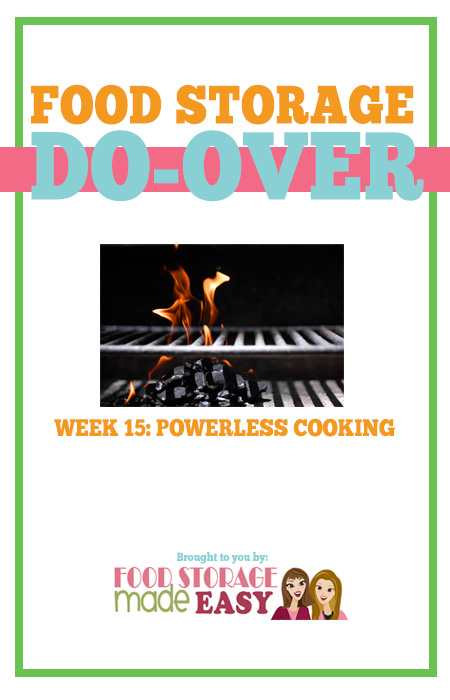We are excited to be starting week 15 of our Food Storage Do-Over 2015! We are getting close to the end of this adventure. If you didn’t catch last week’s post which talked about Sanitation and First Aid you can see it here.
Remember this is a 17 week process that we will be going through together. If you want to join in with the group on Facebook click here. If you’d like to receive email notifications of each week’s do-over assignment you can join our mailing list here. Or you can always post in the blog comments with your progress as well! It is so much more fun and motivating doing it as a group so find a way to connect!

Emergency preparedness is a very broad topic. This week we are going to be working on a plan for powerless cooking. We always recommend starting with inexpensive or do-it-yourself cooking tools so you at least have SOMETHING to use in an emergency. Then as you practice and learn what your family uses the most, you can start to invest in higher quality tools over time.

Fuels
In order to cook without power, you must have some sort of fuel. We love to use the sun as our main fuel source as much as possible, but if you don’t have a way to cook using solar power yet, here are some other fuel options for you.
- Wood
- Charcoal
- Propane
- Butane
- InstaFire Read our overview
- ReadyFuel Read our overview
- Fuel Discs Read our overview
For a printable overview of the common fuels click here.
For a video overview see below:
Do-It Yourself Stoves/Ovens
If you have empty #10 cans hanging around the house you can make a simple #10 Can Stove to use for boiling water or heating up just add water meals.
For a printable tutorial click here.
For a video overview see below:
If you’d like the option to cook baked items like casseroles, cakes, and bread you will need to make an oven. You can make an easy-to-use cardboard box oven that cooks using charcoal.
For a printable tutorial click here.
For a video overview see below:
Inexpensive Stoves
Any number of inexpensive camping stoves can be purchased at camping stores or from Amazon.com. Take a look at what fuels they use as that can impact your decision a lot.
Butane Stoves – We love these because you can cook INDOORS and store the fuel indoors. You can get about 4-5 cook hours out of one butane canister.
Cube Stove – This is an inexpensive little stove that burns fuel pellets. Lightweight and great to throw into 72 hour kits
Firebox – Similar to a cube stove but higher quality and folds flat. The design helps manage airflow so it is very efficient at conserving fuel. Lots of different fuels can be used in it.
TASKS FOR THIS WEEK
- Research these fuels and inexpensive stoves
- Purchase or make at least one stove you can use
- Accumulate a 30 day supply of fuel to cook on whichever stove you buy/make
Don’t forget to come over and share your progress in our Food Storage Do-Over Facebook Group!

If you are an emergency preparedness veteran you may have already looked into some of the larger, longer-term stoves and ovens. Here is a summary of the ones that we have and use ourselves. There are others out there but these are the ones we have the most experience with. Do your own research and find what will meet YOUR family’s needs.
All-American Sun Oven
If you can cook with the sun, it is going to be best bet for conserving your fuel. Solar power is renewable and unlimited, as long as it’s a sunny day! We use Sun Ovens as our primary cooking device and keep other tools as back-up for cloudy days.
View our webinar (and special offer) on the All-American Sun Oven by clicking here.
View an older video featuring the Global Sun Oven below:
Helius Rocket Stove
This is a heavy duty outdoor stove that can be used as an open fire or to cook with pots on top. It can withstand the weight of a full pressure cooker, and can keep temperatures constant enough for pressure cooking. Designed for fuel efficiency and to reduce smoke, this is a great little stove.
View our post introducing this stove by clicking here.
View a video introduction below:
Volcano Collapsible Grill
The Volcano Grill is a more portable stove and is very versatile in that it can use a wide variety of fuels for cooking. It can be used as an open fire pit, as a grill, for dutch oven cooking, boiling water, or even for baking if you have the “tent lid”. Great to throw in the car for a quick evacuation or camping trip.
View more details about the Volcano Grill by clicking here.
View a video introduction below:
HERC Tea Light Ovens
The HERC Tea Light Ovens solve the dilemma of how to BAKE indoors when the power is out. It’s not always feasible or recommended to be outside in an emergency situation. You can bake in these ovens using just a few tea light candles. The smaller “eco” oven works like a crock pot and uses ten tea lights. The larger “XXL” oven uses twenty tea lights and cooks like a 350 degree oven. Fuel cost is about $0.40 per hour and you can get 4 hours of solid cook time out of each batch of candles.
View post introducing these ovens by clicking here.
View a video introduction below:
Tasks for this week
- Inventory your powerless cooking tools and fuel
- Determine how long you could cook using the fuel you have on hand
- Research some of the longer term stoves/ovens shown above
- Purchase or make a plan to save up for any appliances you’ve been wanting
- Organize your storage area so that your tools are easy to access
- Make a goal to practice cooking without electricity at least one time per week this summer
Don’t forget to come over and share your progress in our Food Storage Do-Over Facebook Group!

 |
ReadyFuel: This is a new product from Lindon Farms. It is a gel that can be used indoors or outdoors, and won’t freeze, evaporate, or melt. It’s very light and each packet contains a little metal sheet that can be turned into a holder for your pot. It’s a great little fuel for camping or small cooking needs like boiling water. |
 |
InstaFire: If you’ve followed our blog for a while you will know that we think InstaFire is a great product. It can be stored inside in convenient buckets, it burns in any kind of weather, and will even burn wet wood. It is handy to use in any kind of portable stove or even just on the ground. It’s definitely a nice supplement to go along with your other fuels. |
 |
Fuel Disks: There are a few companies putting out fuel pellets or pucks that can be used in stoves such as the Firebox, or Cube Stove. The disks can be re-used if you don’t use the whole thing. They are easy to burn but must be used outside. They store easily and conveniently indoors or out. They are a very efficient fuel with one pellet lasting for one hour of cooking. |

Here are some resources both from us and all over the web that can help you if you want more depth on any areas or are looking for even more ideas of items to include in your plans. It’s always a good idea to look at multiple approaches and decide what will work best for you! And don’t forget to check out the discussions on our facebook group to catch anything we are missing or see what others are doing!
PINTEREST BOARD ON POWERLESS COOKING
Types Of Fuel
Cooking Stoves
Global Sun Oven
All American Sun Oven
Fuel Disks
InstaFire
ReadyFuel
Butane Stoves
Wonder Box Oven
Dutch Oven Cooking Overview
Video: Powerless Cooking Event
Handout: Powerless Cooking Fuels Handout
Handout: Tutorial On How To Make A #10 Can Stove
Handout: Tutorial On How To Make A Cardboard Box Oven
Handout: Tutorial On How To Make A Wonderbox Oven
10 Ways To Practice Powerless Cooking This Summer
Please pin and get your friends joining in too!


-Jodi Weiss Schroeder
http://foodstoragemadeeasy.net

